Our educational system has not undergone any change with the change brought about by political independence. It bears no imprint of freedom and appears to be as listless as it used to be during the days of slavery. Our universities still remain glued to that old colonial era pattern. The imperfections of that pattern are now keenly felt and there is a great need to introduce a radical change in the educational system.
Low literacy rate and poor quality of education are the major drawbacks of the educational system in Pakistan. Our education system is influenced by a number of factors. Some of them are more prominent, such as low enrolment and high dropout rate at the primary level, different standards of education, low budget allocation for education sector, political interference, low quality of curricula and textbooks, rapid growth in population, poverty and unemployment, poor quality of teachers and irrelevant induction of duties, and our substandard evaluation system. Although the government claims for some bold steps to overcome these problems, there is still room for improvement.
On the other hand, the students play no active role in the attainment of knowledge. Their entire education is passive and mechanical. Our educational system, in the words of Dr Annie, is just cramming the boy’s head with a lot of disjointed facts poured into the head as into a basket, to be emptied out again in the examination room, and the empty basket carried out again into the world. This is the reason why a student who succeeds so well in his college examination fails so miserably in the examination of life. Students have no love of wisdom, no thirst of knowledge, but only a desire to get certificates and diplomas to find reasonable jobs.
There are many complaints about Pakistan’s primary schools and the lack of quality education found in them. One of the main concerns is the lack of proper teaching, teacher training and teacher motivation. Teachers are not professional and they are damaging the whole system.
In view of the foregoing defects and imperfections, our system of education calls for a change. One of the first and most important tasks is that we have to improve our educational machinery. We have to develop schemes of education so that complete and harmonious improvement can be possible.
Looking at the Demand Side of Education
Education around the globe is considered as the defining feature of economic and social development. Pakistan on the supply side has clearly lagged behind in provision of adequate educational resources and consequently on the demand side has failed in creating a clear demand for education. However, it is important to realize that the problems which hinder the provision of education are not just of mismanagement by government but some of them are deeply rooted in the social and cultural orientation of the people. Overcoming the latter is difficult and would require a change in attitude of the people until then universal primary education is difficult to achieve.
Many reasons could be attributed to it:
Gender Discrimination
Major factors that hinder enrollment rates include opportunity cost, poverty, cultural constraints, illiteracy of parents and parental concerns about safety and mobility of their daughters. The economic benefits from schooling are particularly doubtful for girls as society approves of Pardah. Also, since girls have a labor force participation rate of only 4.3% of total population the returns to education seems minimal. Female enrollment rates are low as schooling system is considered to have a bad impact on girl’s character. Society’s emphasis on girl’s modesty, protection and early marriages may limit family’s willingness to send them to school. Enrollment by rural girls is 45% lower than that by urban girls; while for boys the difference is of 10% only, showing that gender gap is another factor. There exists a positive relation between enrollment and household incomes. Recent studies have shown that income shocks (death of family member or animals) affect enrollments, with greater impact for girls
Cost Of Education
The cost of education is another determinant for parents to decide whether to send their children; to government schools, private schools or no schools. Cost of education has increased further due to increased inflation. Educating a child in public school costs twice to society as would cost in private school. Although private schools appear cheaper but government fees appear “free” to parents, however society bears the cost by paying taxes (Andrabi et.al 40). Societal “cost of learning” is lower in private schools, but private schools are located in richer settlements only. The paradox is that private schools are better but not everywhere and governments schools ensure equitable access but do not provide quality education.
Returns to Education – A Misconception
The issue with non-achievement of primary education to all is due to the low enrollment rate coupled with very low retention rate; especially for girls. Geeta Kingdon, in “Education, Skills, and Labor Market Outcomes: Evidence from Pakistan” explained that returns to education are significantly greater for women than men in almost all occupations. This could be due to scarcity of educated women nevertheless; women actually earn less than men because of lack of equal opportunities. Moreover, returns to wage employment as well as returns to self-employment increase with the increasing years of education for both genders. This implies the presence of misconception of education having negative returns due to the forgone income. Thus there is a strong need to make the students and their parents aware that returns to education increase with an additional year of education.
Thus, to improve the cynical condition of education in Pakistan not just provision of education has to be focused upon by the government but the problems of demand side of education needs to be addressed as well. Only then could there be a hope for higher enrollment rates accompanied with proper retention and low drop outs rate. Parents and society in general has to reshape its preferences and thinking about education for the system to improve. And to supplement this government has to provide the resources along with diverse opportunities to provide proper returns to education. Equality of opportunities where returns of education could be compensated is the key to fix the demand side problems of education.
We can improve our education system if we adopt modern method for teaching. There should be commitment of the teachers with their profession and private educational institutions should play their active role. Educational policies with complete check and balance should be implemented.
Education system should provide not mere book worms and job hunters, but intelligent citizens.
Book Source:
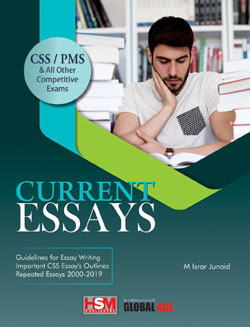
CSS Current Essays
Book Price: 495
Whatsapp your order at 03000459551 to get book at your doorstep with cash on delivery
Check our Collection of English Essays specially for CSS
- Essay Outline: Electoral Reforms in Pakistan: Necessity and Challenges
- Health for All | Essay Outline for CSS PMS
- Exploring the Economic Potential of BRICS Countries: Opportunities and Challenges
- Art and Morality Essay Outline
- Instruction in Youth is Like Engraving in Stone | Complete Essay with Outline
- Public Office is a Public Trust | Complete CSS Essay
- Essay Outline “Good Governance is deeply rooted in Human Development”
- CSS Essay Outline | The Importance of Water Conservation and Management
- How to Write Effective Essay for CSS Exams
- How to Write Effective Essay on Economy? 7 Steps

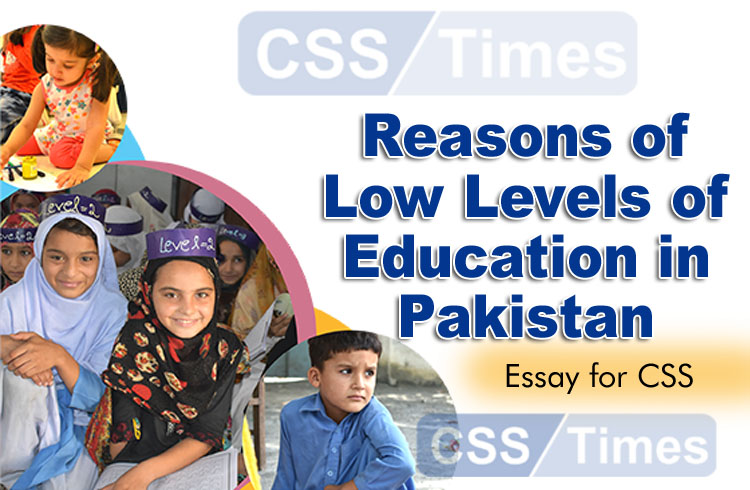
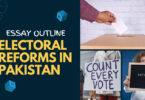
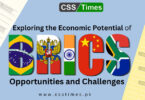


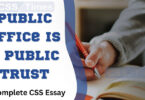

[…] Reasons of Low Levels of Education in Pakistan (Essay for CSS) […]